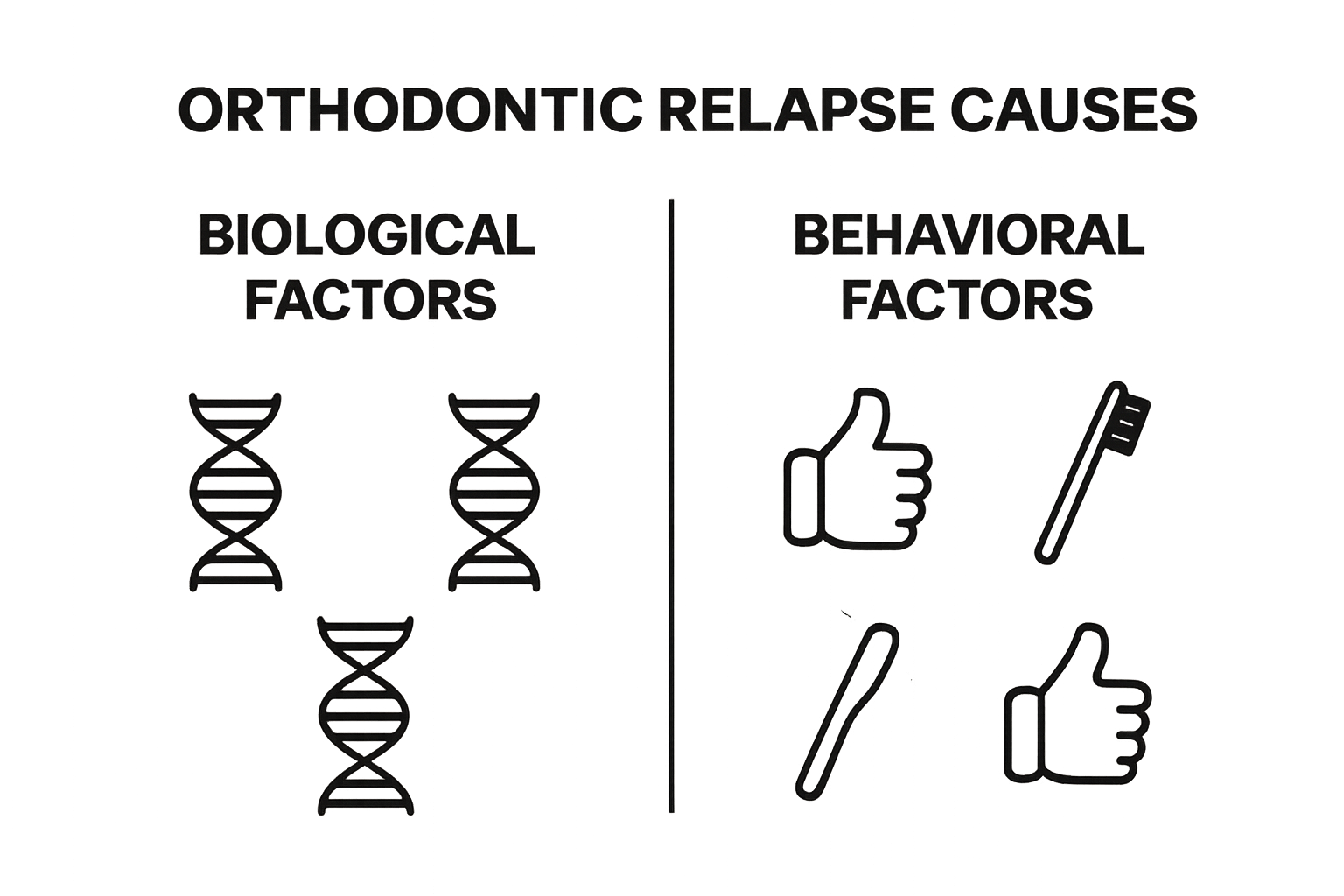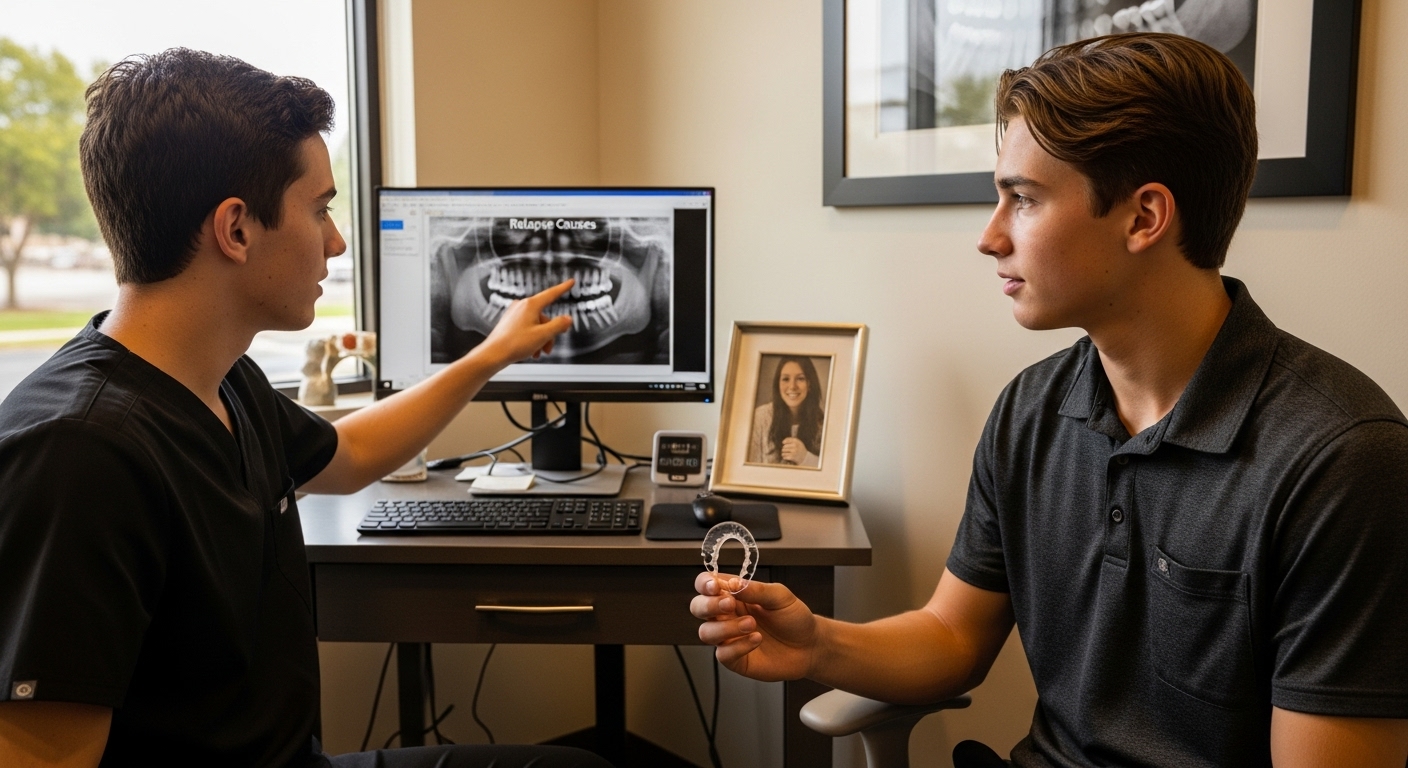Understanding Orthodontic Relapse Causes for Families
September 26, 2025
Understanding Orthodontic Relapse Causes for Families
People spend months or even years in braces, expecting their new smile to last forever. But studies show that up to 70 percent of orthodontic patients experience noticeable teeth shifting after treatment. Most assume that a retainer for a few months will keep everything in place. Turns out, the real reason teeth move back after braces is hidden in your own biology, and the fight against orthodontic relapse is a lot tougher than most expect.
Table of Contents
- What Is Orthodontic Relapse And Why Does It Happen?
- The Importance Of Retainers In Preventing Relapse
- How Bone And Tissue Changes Affect Orthodontic Stability
- Common Factors Contributing To Orthodontic Relapse
- Long-Term Care For A Lasting Smile After Orthodontics
Quick Summary
| Takeaway | Explanation |
|---|---|
| Retainers are essential post-treatment. | Wearing retainers helps maintain teeth in their new positions and prevents orthodontic relapse. |
| Age influences stability. | Younger patients generally experience better stability in their orthodontic results compared to adults. |
| Genetics and biology affect retention. | Individual biological factors, such as tissue elasticity, can impact how well teeth remain aligned after treatment. |
| Routine check-ups are crucial. | Regular visits to the orthodontist can help identify and address potential alignment issues before they worsen. |
| Proper oral hygiene supports long-term results. | Maintaining good dental care habits, including consistent cleaning and avoiding harmful practices, enhances the stability of your smile. |
What is Orthodontic Relapse and Why Does It Happen?
Orthodontic relapse represents an unexpected challenge that occurs after completing orthodontic treatment, where teeth gradually shift back toward their original misaligned positions. This phenomenon can frustrate patients who have invested significant time and resources into achieving a perfect smile.
Understanding the Biological Mechanism
At its core, orthodontic relapse stems from complex biological processes within the mouth. When teeth are moved during orthodontic treatment, the surrounding periodontal ligaments and bone structures undergo substantial changes. According to research published in the International Journal of Dentistry, these tissues require time to fully adapt to new tooth positions, which creates an inherent tendency for teeth to return to their original alignment.
Key factors contributing to orthodontic relapse include:
- Natural muscle memory of soft tissues
- Residual tensions in periodontal fibers
- Individual genetic predispositions
- Incomplete stabilization of new tooth positions
Factors Influencing Relapse Potential
Multiple elements can increase the likelihood of orthodontic relapse. Age plays a significant role, with younger patients typically experiencing more stable results compared to adults. Genetic factors, jaw structure, and the complexity of initial misalignment also substantially impact the potential for teeth to shift back.
Patients should understand that some degree of movement is normal after orthodontic treatment. The goal is not absolute perfection but managing and minimizing potential relapse through proper retention strategies. Regular follow-ups, consistent use of retainers, and maintaining good oral hygiene can significantly reduce the risk of substantial orthodontic regression.
The Importance of Retainers in Preventing Relapse
Retainers serve as the critical final step in orthodontic treatment, acting as a guardian against the natural tendency of teeth to drift back to their original positions. These custom-designed dental appliances play a pivotal role in maintaining the precise alignment achieved through braces or clear aligners.
Types of Retainers and Their Functionality
Orthodontists typically recommend two primary types of retainers: removable and fixed. According to research from the American Association of Orthodontists, each type offers unique benefits in preventing orthodontic relapse.
Removable retainers include:
- Clear plastic retainers that fit snugly over teeth
- Traditional wire and acrylic Hawley retainers
- Custom-molded transparent aligners
Fixed retainers consist of a thin wire permanently bonded to the back of front teeth, providing continuous stabilization. The choice between removable and fixed retainers depends on individual patient needs, initial tooth alignment, and specific orthodontic challenges.
The table below compares the features, benefits, and considerations of the most common types of orthodontic retainers discussed in the article.
| Retainer Type | Description | Benefits | Considerations |
|---|---|---|---|
| Clear Plastic | Transparent, custom-molded appliance placed over teeth | Nearly invisible, easy to use | Can be lost or damaged if removable |
| Hawley (Wire & Acrylic) | Acrylic base with metal wires that hold teeth in position | Durable, adjustable by orthodontist | Slightly more noticeable, may affect speech |
| Fixed (Bonded Wire) | Thin wire permanently attached behind front teeth | Continuous stabilization, non-removable | Requires diligent oral hygiene |
| Custom-Molded Aligners | Clear aligner trays designed to fit the patient’s teeth | Removable, comfortable, aesthetic | Must be worn as prescribed |
Long-Term Retention Strategies
The duration and consistency of retainer wear are crucial in preventing orthodontic relapse. Most orthodontic professionals recommend full-time retainer use immediately after treatment, gradually transitioning to nighttime wear. Initial retention period typically spans 6-12 months, with continued nighttime use recommended for several years or even indefinitely to maintain tooth alignment.
Patients must understand that retainers are not just a temporary solution but a long-term commitment to preserving their orthodontic investment. Regular check-ups, proper cleaning, and consistent wear are essential in preventing the gradual shifting that can compromise years of orthodontic treatment.
How Bone and Tissue Changes Affect Orthodontic Stability
Orthodontic treatment triggers complex biological transformations within the oral environment, fundamentally altering the structural relationships between teeth, bone, and surrounding soft tissues. Understanding these intricate changes is crucial for comprehending the potential for long-term dental alignment stability.
Biological Remodeling Process
When orthodontic forces are applied, teeth undergo a sophisticated process of bone resorption and deposition. According to research published in the Journal of Dental Research, this remodeling involves precise cellular interactions that allow teeth to move through bone tissue. The periodontal ligament acts as a critical mediator, facilitating controlled movement while simultaneously maintaining tissue integrity.
Key biological processes during orthodontic movement include:
- Osteoclast activation for bone resorption
- Osteoblast recruitment for new bone formation
- Cellular signaling that guides tissue adaptation
- Mechanical stress response mechanisms
Tissue Adaptation and Stability Factors
The stability of orthodontic treatment depends on multiple interconnected biological factors. Genetic predisposition significantly influences how quickly and effectively tissues can remodel. Some individuals demonstrate more rapid adaptive responses, while others may experience slower tissue reorganization.
Tissue memory plays a critical role in potential tooth relapse. The surrounding muscular and fibrous tissues retain their original positioning tendencies, which can gradually pull teeth back toward their initial alignment. Orthodontic professionals must carefully manage these biological dynamics to ensure long-term treatment success, recognizing that each patient’s physiological response is unique.
Common Factors Contributing to Orthodontic Relapse
Orthodontic relapse represents a complex interplay of biological, physiological, and behavioral factors that can undermine years of careful dental alignment. Understanding these diverse contributors helps patients and orthodontic professionals develop more effective long-term treatment strategies.
Physiological and Genetic Influences
Individual biological characteristics play a significant role in potential tooth movement. According to research from dental genetics studies, some patients are predisposed to greater tissue instability due to their genetic makeup. Inherent tissue memory and cellular response mechanisms can create natural pressures that gradually shift teeth back toward their original positions.
Key physiological factors include:
- Individual bone density variations
- Genetic predispositions to tissue elasticity
- Muscular and soft tissue tension patterns
- Jaw growth and development characteristics
Behavioral and Environmental Contributors
Patient behaviors and environmental factors significantly impact orthodontic stability. Persistent oral habits, such as tongue thrusting, teeth grinding, or improper swallowing patterns, can create continuous forces that challenge dental alignment. Lifestyle factors like nutritional intake, sleep patterns, and overall physical health also play crucial roles in maintaining orthodontic treatment results.
Additionally, age-related changes continue to influence dental positioning throughout an individual’s lifetime.
This table summarizes the major physiological, genetic, behavioral, and environmental contributors to orthodontic relapse as described in the article.
| Factor Category | Specific Examples Mentioned | Impact on Tooth Stability |
|---|---|---|
| Physiological & Genetic | Bone density, tissue elasticity, jaw growth, genetic predisposition | Influences how stable teeth remain after treatment |
| Soft Tissue Memory | Muscle memory, residual periodontal fiber tension | Causes gradual tendency for teeth to return to original position |
| Behavioral Habits | Tongue thrusting, teeth grinding, improper swallowing | Creates ongoing force that can shift teeth |
| Environmental & Lifestyle | Nutrition, sleep patterns, age-related changes, physical health | Affects bone and tissue adaptation, influencing long-term results |
 Bone density modifications, hormonal shifts, and natural wear patterns can gradually alter tooth alignment, making consistent retainer use and periodic professional monitoring essential for long-term success.
Bone density modifications, hormonal shifts, and natural wear patterns can gradually alter tooth alignment, making consistent retainer use and periodic professional monitoring essential for long-term success.
Long-term Care for a Lasting Smile After Orthodontics
Maintaining the beautiful results of orthodontic treatment requires a comprehensive, proactive approach that extends far beyond the completion of initial alignment. Patients must understand that preserving their new smile demands ongoing commitment and strategic dental care.
Professional Monitoring and Maintenance
Regular professional assessments are crucial in preventing potential orthodontic regression. According to research from the American Journal of Orthodontics, periodic check-ups allow orthodontists to detect and address subtle shifts before they become significant problems. These professional evaluations serve as a critical early warning system for potential tooth movement.
Key professional maintenance strategies include:
- Annual comprehensive orthodontic evaluations
- Digital tracking of tooth positioning
- Precise measurements of dental alignment
- Personalized retention strategy adjustments
Personal Oral Hygiene and Lifestyle Considerations
Personal habits and daily oral care play a significant role in maintaining orthodontic results. Consistent oral hygiene practices directly impact the long-term stability of dental alignment. This includes not just regular brushing and flossing, but also being mindful of habits that could potentially compromise tooth positioning.
Patients should focus on holistic approaches that support dental stability, including proper nutrition, stress management, and addressing any underlying oral health conditions. Wearing retainers as prescribed, practicing mindful eating, and avoiding harmful habits like teeth grinding remain critical components of long-term smile preservation.

Safeguard Your Family’s Smile from Orthodontic Relapse
Worried about all your hard work slipping away because of orthodontic relapse? If you or your child have experienced teeth shifting after treatment, you know how frustrating it feels to see your investment in a glowing smile put at risk. The article above explains that challenges like muscle memory, tissue changes, and not wearing retainers can create real setbacks. At Glow Orthodontics, our team helps families in Langley understand every step of the journey and provides the right tools and support to keep your results stable for life.

Take control now and protect what matters most. Book a personalized evaluation at Glow Orthodontics to get expert advice on retainers, long-term monitoring, and solutions tailored to your family’s needs. Discover a warm, patient-centered office and explore how our orthodontic treatments and Invisalign options can keep your smile shining for years to come. Secure your lasting results with support from a trusted partner—schedule your consultation today at https://gloworthodontics.ca.
Frequently Asked Questions
What is orthodontic relapse?
Orthodontic relapse is the gradual movement of teeth back toward their original misaligned positions after orthodontic treatment has been completed.
What causes teeth to shift back after braces or aligners?
Teeth may shift due to natural muscle memory of soft tissues, residual tensions in periodontal fibers, genetic predispositions, and incomplete stabilization of new tooth positions.
How can retainers help prevent orthodontic relapse?
Retainers are custom-designed appliances that maintain the achieved alignment by preventing teeth from drifting back to their original positions. They can be removable or fixed, and consistent use is essential for long-term stability.
What should I do if I notice my teeth shifting after orthodontic treatment?
If you notice any shifts in your teeth after treatment, it’s important to contact your orthodontist for an evaluation. Regular check-ups can help detect any changes early and allow for timely adjustments to your retention strategy.